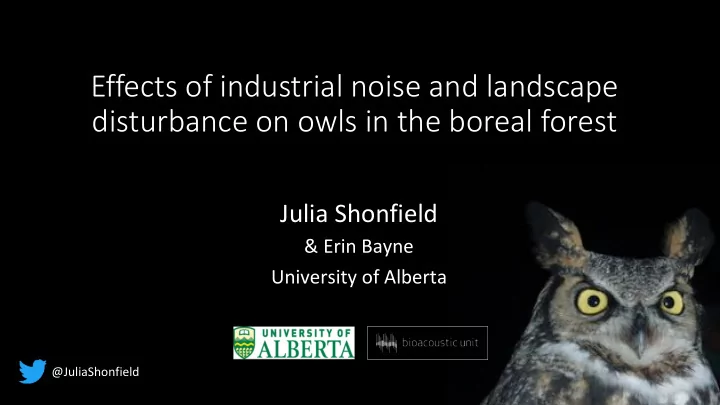

Effects of industrial noise and landscape disturbance on owls in the boreal forest Julia Shonfield & Erin Bayne University of Alberta @JuliaShonfield
Anthropogenic disturbance is increasingly affecting previously undisturbed areas, and can have negative effects on species populations and alter the behaviour of individuals. Anthropogenic disturbance: Physical footprint Sensory disturbance
Growing concern that noise pollution from anthropogenic sources can degrade ecosystem integrity. Anthropogenic noise can mask communication signals important to an animal’s life history
Studies of noise on owls: Effects of temporary anthropogenic noise sources on spotted owls • (Delaney et al. 1999, Tempel & Gutiérrez 2003, Hayward et al. 2011) Owl density and occupancy of sites has been found to decrease with • proximity to roads (Hindmarch et al. 2012, Silva et al. 2012)
Masking of owl calls due to noise 1 kHz Industrial noise 1 kHz Boreal owl call
Effects of noise on owl hunting: Increased anthropogenic noise levels negatively affect hunting • success and foraging efficiency of owls Mason et al. 2016; Senzaki et al. 2016
Effects of noise vs effects of other disturbance Recent studies have shown small effects of noise on songbirds compared to other types of disturbance (e.g. infrastructure) Bernath-Plaisted & Koper 2016, Nenninger & Koper 2018 What is the relative importance of different types of disturbance on the landscape on owl habitat use? Putting the effects of noise into context
Research Objectives 1. Assess the impact of industrial noise on owls by determining if they avoid noise sources. 2. Evaluate potential cumulative effects and assess the relative importance of different types of industrial disturbance on habitat use by owls in the boreal forest of northeastern Alberta.
Autonomous recording units (ARUs) Used ARUs to conduct passive owl surveys
Study species Barred ow l Boreal owl Great horned owl
Processed recordings using owl call recognizers Barred owl Boreal owl Great horned owl Shonfield et al. 2018. Journal of Raptor Research
Plant facility Well pad on a road Compressor Well pad on a pipeline station
s e t i s e s i o n t n e t t i m r e t n I Plant facility Well pad on a road No noise sites Compressor Well pad on a pipeline station
1.6 km NW NE CT 1.6 km 2.56 km 2 SW SE
ARUs set to record for 1.6 km 10 minutes/hour NW NE Deployed for 2 weeks/ site CT 1.6 km C2 2.56 km 2 SW SE
Occupancy analysis at two spatial scales MacKenzie et al. 2002 N = 72 sites N = 353 stations
Results – Owl detections • Barred owls – 40% of sites, 13% of stations surveyed • Great horned owls – 81% of sites, 41% of stations surveyed • Boreal owls – 39% of sites, 16% of stations surveyed
Results Site level occupancy – larger scale Shonfield & Bayne. 2017. Avian Conservation and Ecology
Results Station level occupancy – smaller scale Shonfield & Bayne. 2017. Avian Conservation and Ecology
Results - forest composition and human footprint Shonfield & Bayne. 2017. Avian Conservation and Ecology
Summary – Effects of noise Industrial noise sources had no effect on occupancy at Barred ow l either scale by barred owls, great horned owls, and boreal owls No evidence of avoidance of noise sources Great horned owl Boreal owl Shonfield & Bayne. 2017. Avian Conservation and Ecology
Summary - Effect of total human footprint Occupancy by barred owls (-) affected by total human footprint How do different disturbances affect owl habitat use? Shonfield & Bayne. 2017. Avian Conservation and Ecology
Owl survey locations Compiled recordings from ARUs at 452 locations (spaced min. 1.2 km) 2013: 153 locations 2014: 104 locations 2015: 134 locations 2016: 51 locations
Disturbance types Facilities Cutblocks Hard linear features Low activity clearings High activity clearings Soft linear features
Disturbance types t n e s e i t o t n i m c r i n e t o n r h I C e s i o n Facilities Cutblocks Hard linear features t n e t t i m r e t n I e s i o n Low activity clearings High activity clearings Soft linear features
Analysis – Boosted regression trees • Used boosted regression trees (BRTs) to assess the relative importance of human disturbance and other landcover variables on owl habitat use • BRTs can handle different types of predictor variables, fit complex nonlinear relationships, and handle interaction effects between predictors Elith et al. 2008
Results – Owl detections • Barred owls – present at 18% of ARU locations • Great horned owls – present at 50% of ARU locations • Boreal owls – present at 21% of ARU locations
Results – Relative influence of variables Barred owl Great horned owl Boreal owl
Results – Barred owl presence
Results – Great horned owl presence
Results – Boreal owl presence
Summary Species-specific responses to disturbance • Barred owls – sensitive to human disturbance (less likely to be present in areas with more roads and total footprint) • Great horned owls – relatively tolerant to disturbance (present in areas with more soft linear features, but avoid large facilities) • Boreal owls – clear pattern for effect of forest composition, patterns of effects of disturbance were less clear
Summary – Implications & future work • For owls, reducing the physical footprint of disturbance likely more important than mitigating noise, in terms of owl occurrence • Better understanding of how landscape disturbance affects owl survival and reproduction
Funding Support 35
Thanks to Bayne lab grad students, undergrads, field Supervisor & committee: techs, acoustic lab techs, & logistical support: Erin Bayne Evelyn Merrill Janet Ng Anjolene Hunt Elly Knight Jocelyn Gregoire Andrew Derocher Natalie Sanchez Emily Upham-Mills Natasha Annich Connor Charchuk Sarah Heemskerk Dan Yip Cassandra Hardie Alex MacPhail Lindsay Valliant Michelle Knaggs Hedwig Lankau Logan McLeod Monica Kohler Scott Wilson Brandi Mogge Jill Cameron Nicole Boucher 36
Recommend
More recommend